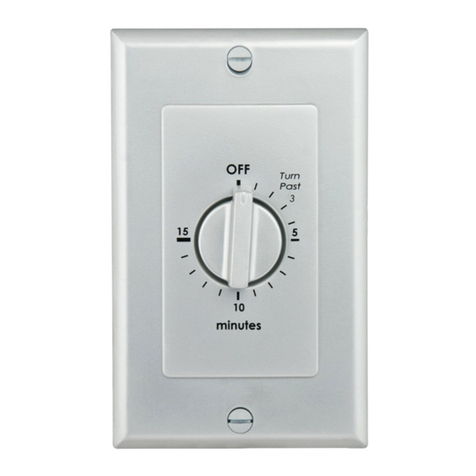
INSTRUCTIONS FOR THE RELIANCE
Panel/Link
®
- TC Series
THE RELIANCE PANEL/LINK® TRANSFER PANEL IS
NOT FOR “DO-IT-YOURSELF” INSTALLATION. It
must be i stalled by a qualified electricia thoroughly
familiar with all applicable electrical a d buildi g
codes.
This Reliance Panel/Link® Transfer Panel contains the
transfer mechanism for providing an alternate input from a
supplemental power source, such as a generator. In the
event of a power outage, it is designed to provide a safe
and simple method of powering the panel bus from a
portable generator. The uni ue factory-installed
mechanical interlock between the circuit breakers feeding
the panel bus prevents feedback by prohibiting the Utility
breaker and the Generator breaker from being in the “ON”
position at the same time.
KEY COMPONENTS OF THE PANEL/LINK®
TRANSFER PANEL
UTILITY CIRCUIT BREAKER. This is the double-pole
circuit breaker on the left-hand side of the panel, and it
controls the supply of power from the utility line to the
panel bus. It will generally be “ON” when utility power is
present.
GENERATOR CIRCUIT BREAKER. This is the double-
pole circuit breaker located directly to the right of the Utility
breaker. This controls the supply of power from the
alternate source, such as a generator. It will remain “OFF”
when the Utility circuit breaker is “ON”.
BREAKER INTERLOCK MECHANISM. This is the
mechanical linkage located between the Utility circuit
breaker and the Generator circuit breaker. It prevents
both of these breakers from being in the “ON” position
simultaneously, and is the safety feature that prevents
feedback between the utility source and the generator.
INSTALLATION
DANGER! HAZARDOUS VOLTAGE. DISCONNECT
ALL ELECTRICAL SUPPLY SOURCES BEFORE
INSTALLATION AND WHEN SERVICING CONNECTED
EQUIPMENT OR CIRCUITS.
This panel is installed in a manner similar to either a service
entrance load center or a sub panel, and in accordance
with all applicable electrical codes. See the wiring diagram
on the inside cover of the panel. If being used as a sub
panel, a separate grounding bar must be added to the
panel. If being used as service entrance e uipment, the
ground screw provided must be used to bond the cabinet
to the neutral/ground bar. Separate ground and neutral
wires of the appropriate size must be installed between the
transfer panel and any other panel or panels either being
feed by or from the transfer panel.
For generator connections and operation follow the
generator manufacturer’s instructions, as well as all
applicable code re uirements. Your generator must have a
combination 120/240 volt output, which duplicates that
provided by the electric utility. The two 240 volt hot legs of
this output must be connected to the two Generator circuit
breaker terminals. The neutral of this output must be
connected to the transfer panel neutral bar, thus providing
the re uired combination 120/240 volt input. To facilitate
connection to the transfer panel, a remotely located Power
Inlet Box such as the Reliance Cat. No. PB30 or PB50
may be convenient
OPERATION
TRANSFERRING FROM UTILITY POWER TO
GENERATOR POWER
1. Move Utility circuit breaker handle to the “OFF”
position.
2. Move all branch circuit breaker handles in panel being
feed by the transfer panel to the “OFF” position.
3. Move Generator circuit breaker handle to the “ON”
position.
4. Insert the male power cord connector plug into the
appropriate outlet on the generator. Rotate to lock.
5. Plug the female end of the power cord from the
generator into the power inlet that is interconnected to the
transfer panel. Rotate to lock.
6. Start the generator, following the procedures described
in the generator owner’s manual furnished by the
generator manufacturer.
7. Select the circuits to be powered by the generator by
moving the corresponding branch circuit breaker handles
to the “ON” position. Alternate use of larger loads such as
furnace motors, well pumps, freezers, etc., so that the
capacity of the generator is not exceeded. Do not attempt
to operate any loads in excess of the capacity of the
generator.
TRANSFERRING FROM GENERATOR POWER BACK
TO UTILITY POWER
1. Follow the procedures in the generator owner’s manual
to turn off the generator.
2. Unplug the power cord.
3. Move the Generator circuit breaker handle to the “OFF”
position.
4. Move the Utility circuit breaker handle to the “ON”
position.
5. Return all branch circuit breaker handles to the “ON”
position.
To insure that your generator will always be ready when
you need it, it is very important to run it under load on a
regular basis and to keep the tank filled with fresh fuel.
Perform the above operating steps at least once a month
to keep the generator properly exercised.
INSTRUCTIONS POUR LA RELIANCE
Panel/Link
®
- TC Series
LE PANNEAU DE TRANSFERT DE PANEL/LINK® DE
CONFIANCE N’EST PAS POUR L’INSTALLATION DE «
BRICOLAGE ». Il doit être installé par un électricien
ualifié et parfaitement au courant de tous les codes
électri ues et de construction applicables.
Ce panneau de Reliance/lien panneau de transfert®
contient le mécanisme de transfert pour fournir une entrée




















